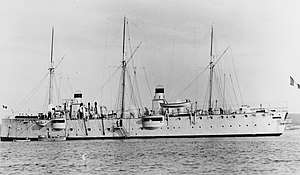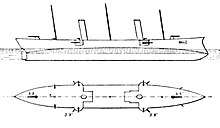French cruiser Infernet
Infernet was the second and final member of the D'Estrées class of protected cruisers built for the French Navy in the 1890s.
 Infernet | |
| History | |
|---|---|
| Name: | Infernet |
| Builder: | Forges et Chantiers de la Gironde |
| Laid down: | December 1896 |
| Launched: | 7 July 1899 |
| Completed: | 1900 |
| Fate: | Wrecked, 22 November 1910 |
| General characteristics | |
| Class and type: | Destrées-class cruiser |
| Displacement: | 2,428 long tons (2,467 t) |
| Length: | 95 m (311 ft 8 in) loa |
| Beam: | 12 m (39 ft 4 in) |
| Draft: | 5.39 m (17 ft 8 in) |
| Installed power: |
|
| Propulsion: |
|
| Speed: | 20 to 20.5 knots (37.0 to 38.0 km/h; 23.0 to 23.6 mph) |
| Range: | 6,000 nmi (11,000 km; 6,900 mi) at 10 kn (19 km/h; 12 mph) |
| Complement: | 235 |
| Armament: | |
| Armor: | Deck: 38 to 43 mm (1.5 to 1.7 in) |
Design

In the 1880s and 1890s, factions in the French Navy's officer corps argued over the types of cruiser that best served France's interests. Some argued for a fleet of small but fast protected cruisers for commerce raiding, another sought ships useful for patrolling the country's colonial possessions, while another preferred vessels more suited to operations with the home fleet of battleships. The two cruisers of the D'Estrées class were ordered under the construction program of 1896 at the behest of the colonialists for use in the French overseas empire.[1]
Infernet was 95 m (311 ft 8 in) long overall, with a beam of 12 m (39 ft 4 in) and a draft of 5.39 m (17 ft 8 in). She displaced 2,428 long tons (2,467 t). Her crew numbered 235 officers and enlisted men. The ship's propulsion system consisted of a pair of triple-expansion steam engines driving two screw propellers. Steam was provided by eight coal-burning Normand-type water-tube boilers that were ducted into two widely spaced funnels. Her machinery was rated to produce 8,500 indicated horsepower (6,300 kW) for a top speed of 20 to 20.5 knots (37.0 to 38.0 km/h; 23.0 to 23.6 mph).[2] She had a cruising range of 8,000 nautical miles (15,000 km; 9,200 mi) at a speed of 10 knots (19 km/h; 12 mph).[3]
The ship was armed with a main battery of two 138 mm (5.4 in) 45-caliber guns. They were placed in individual pivot mounts with gun shields, one forward and aft on the centerline. These were supported by a secondary battery of four 100 mm (3.9 in) guns, which were carried in sponsons. For close-range defense against torpedo boats, she carried eight 47 mm (1.9 in) 3-pounder Hotchkiss guns and two 37 mm (1.5 in) 1-pounder guns. Armor protection consisted of a curved armor deck that was 38 to 43 mm (1.5 to 1.7 in) thick.[2]
Service history
Infernet was built at the Forges et Chantiers de la Gironde shipyard; her keel was laid down in December 1896.[2] The ship was launched on 7 September 1899, having already had her propulsion machinery installed,[4][5] and she was completed in 1900.[2] She completed her sea trials later that year, during which she reached a top speed of 21 knots (39 km/h; 24 mph), exceeding her contract speed by half a knot.[6] The ship was named for Captain Louis-Antoine-Cyprien Infernet, a French naval officer who had seen action at the Battle of Trafalgar in 1805.[7] She was initially deployed to the Pacific, where she joined the protected cruiser Protet and the transport vessel Aube.[8]
By January 1901, Infernet had been assigned to the Northern Squadron, which was stationed in Brest, France,[9] though she was not in commission. On 15 March, Infernet was commissioned for a deployment to the East Indies station, where she was to replace the old unprotected cruiser Nielly. The unit was stationed in Madagascar, then a French colony.[10] There, she joined the cruiser Catinat.[11] The two ships remained on the station in 1902, along with a pair of smaller vessels.[12] Infernet was transferred to the East Indies in the western Pacific and Indian Oceans in 1903. On 15 March, she stopped in Muscat to take on coal, and while there, she was visited by Faisal bin Turki, Sultan of Muscat and Oman. The British cruiser HMS Perseus was present at the time, and Infernet's captain visited the cruiser. She made another stop in the port on 15 May, where she was again visited by bin Turki.[13][14] She remained in the region through 1905, along with the gunboat Capricorne and a transport aviso.[15]
After returning to home waters, Infernet was wrecked off Les Sables-d'Olonne on the Atlantic coast of France, but the date is uncertain. According to Warship International, the vessel was stranded there in 1909,[16] but Conway's All the World's Fighting Ships provides the date as 22 November 1910. Regardless of the date, Infernet could not be refloated and she proved to be a total loss.[5]
Notes
- Ropp, pp. 284, 286.
- Gardiner, p. 313.
- Garbett May 1904, p. 563.
- Leyland 1900, p. 29.
- Gardiner & Gray, p. 193.
- Leyland 1901, p. 36.
- Fraser, p. 189.
- Garbett 1899, p. 1026.
- Jordan & Caresse, p. 218.
- Garbett 1901, p. 197.
- Leyland 1901, p. 76.
- Brassey 1902, p. 52.
- Brassey 1903, pp. 62–63.
- Reeve, pp. 84–85, 91–92.
- Garbett June 1904, p. 710.
- Fisher, p. 239.
References
- Brassey, Thomas A. (1902). "Chapter III: Relative Strength". The Naval Annual. Portsmouth: J. Griffin & Co.: 47–55. OCLC 496786828.
- Brassey, Thomas A. (1903). "Chapter III: Relative Strength". The Naval Annual. Portsmouth: J. Griffin & Co.: 57–68. OCLC 496786828.
- Fisher, Edward C., ed. (1969). "157/67 French Protected Cruiser Infernet". Warship International. Toledo: International Naval Research Organization. VI (3): 238–239. ISSN 0043-0374.
- Fraser, Edward (1906). The Enemy at Trafalgar: An Account of the Battle From Eye-Witnesses' Narratives and Letters and Despatches From the French and Spanish Fleets. London: Hodder & Stoughton. OCLC 752897525.
- Garbett, H., ed. (September 1899). "Naval Notes: France". Journal of the Royal United Service Institution. London: J. J. Keliher & Co. XLIII (259): 1024–1027. OCLC 1077860366.
- Garbett, H., ed. (February 1901). "Naval Notes: France". Journal of the Royal United Service Institution. London: J. J. Keliher & Co. XLV (276): 196–199. OCLC 1077860366.
- Garbett, H., ed. (May 1904). "Naval Notes: France". Journal of the Royal United Service Institution. London: J. J. Keliher & Co. XLVIII (315): 560–566. OCLC 1077860366.
- Garbett, H., ed. (June 1904). "Naval Notes: France". Journal of the Royal United Service Institution. London: J. J. Keliher & Co. XLVIII (316): 707–711. OCLC 1077860366.
- Gardiner, Robert, ed. (1979). Conway's All the World's Fighting Ships 1860–1905. London: Conway Maritime Press. ISBN 978-0-85177-133-5.
- Gardiner, Robert & Gray, Randal, eds. (1985). Conway's All the World's Fighting Ships: 1906–1921. Annapolis: Naval Institute Press. ISBN 978-0-87021-907-8.
- Jordan, John & Caresse, Philippe (2017). French Battleships of World War One. Annapolis: Naval Institute Press. ISBN 978-1-59114-639-1.
- Leyland, John (1900). Brassey, Thomas A. (ed.). "Chapter II: The Progress of Foreign Navies". The Naval Annual. Portsmouth: J. Griffin & Co.: 24–62. OCLC 496786828.
- Leyland, John (1901). Brassey, Thomas A. (ed.). "Chapter II: The Progress of Foreign Navies". The Naval Annual. Portsmouth: J. Griffin & Co.: 33–70. OCLC 496786828.
- Reeve, A. (1904). The Commission of H.M.S. Perseus: East Indies. Including Persian Gulf and Somaliland, 1901–1904. London: The Westminster Press. OCLC 38470445.
- Ropp, Theodore (1987). Roberts, Stephen S. (ed.). The Development of a Modern Navy: French Naval Policy, 1871–1904. Annapolis: Naval Institute Press. ISBN 978-0-87021-141-6.